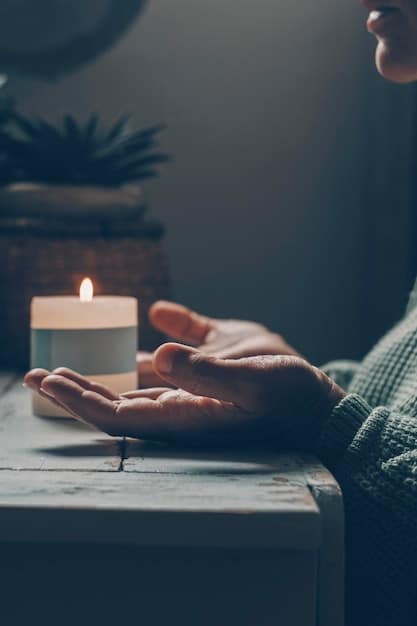Mindfulness Meditation: Reduce Anxiety Symptoms by 15% in 3 Months

Mindfulness meditation can significantly reduce anxiety symptoms, potentially by up to 15%, within just three months through consistent practice and a focus on present moment awareness.
Are you seeking a natural and effective way to manage your anxiety? Discover how mindfulness meditation can reduce anxiety symptoms by 15% in 3 months, offering a path to greater peace and well-being.
Understanding Anxiety and Its Impact
Anxiety is a common mental health concern that affects millions of people worldwide. It can manifest in various ways, from generalized worry to panic attacks, significantly impacting daily life and overall well-being. Understanding the nature of anxiety is the first step toward effectively managing it.
Symptoms of Anxiety
Anxiety can present itself through a range of physical, emotional, and behavioral symptoms.
- Physical symptoms include increased heart rate, sweating, trembling, and muscle tension.
- Emotional symptoms often involve feelings of worry, fear, irritability, and restlessness.
- Behavioral symptoms may include avoidance of certain situations, difficulty concentrating, and sleep disturbances.
The Broader Impact of Anxiety
The impact of anxiety extends beyond individual symptoms, affecting relationships, work performance, and overall quality of life. Chronic anxiety can lead to depression, social isolation, and a host of other issues.
Recognizing the profound effects of anxiety highlights the importance of finding effective management strategies. Mindfulness meditation offers a promising approach, providing tools to calm the mind and reduce the intensity of anxiety symptoms.

The Science Behind Mindfulness Meditation
Mindfulness meditation is a practice that involves focusing your attention on the present moment without judgment. It’s rooted in ancient Buddhist traditions and has gained widespread recognition for its mental and physical health benefits. Let’s explore the science that supports its effectiveness in reducing anxiety.
Numerous studies have investigated the effects of mindfulness meditation on the brain. Research suggests that regular practice can lead to:
- Changes in brain structure, particularly in areas associated with attention and emotion regulation.
- Increased gray matter density in regions like the hippocampus, which plays a key role in memory and learning.
- Reduced activity in the amygdala, the brain’s fear center, leading to decreased feelings of anxiety and stress.
Mindfulness meditation helps regulate the body’s stress response by activating the parasympathetic nervous system, often referred to as the “rest and digest” system. This activation leads to lower heart rate, blood pressure, and levels of stress hormones like cortisol.
How Mindfulness Meditation Works
The key to mindfulness meditation lies in cultivating present moment awareness and non-judgmental acceptance. By focusing on your breath, body sensations, or thoughts as they arise, you learn to observe your experiences without getting carried away by them.
This practice helps you detach from anxious thoughts and feelings, recognizing them as temporary mental events rather than fixed realities. Over time, this can reduce the intensity and frequency of anxiety symptoms, leading to a greater sense of calm and control.
Getting Started with Mindfulness Meditation
Beginning a mindfulness meditation practice is simple and accessible. You don’t need any special equipment or prior experience. Here’s a step-by-step guide to help you get started.
Find a quiet and comfortable space where you can sit or lie down without being disturbed. Set aside 5-10 minutes for your meditation session, gradually increasing the duration as you become more comfortable.
The Basic Steps of Mindfulness Meditation
Follow these steps to guide your mindfulness meditation:
- Sit comfortably with your back straight but not stiff.
- Close your eyes gently or lower your gaze.
- Bring your attention to your breath, noticing the sensation of each inhale and exhale.
- When your mind wanders, gently guide your attention back to your breath.
- Practice non-judgmental awareness, observing your thoughts and feelings without getting caught up in them.
Acknowledge that it’s normal for your mind to wander during meditation. The key is to gently redirect your attention back to your breath each time this happens. With regular practice, you’ll find it easier to stay focused and present.

Integrating Mindfulness into Daily Life
While formal meditation sessions are valuable, integrating mindfulness into your daily routine can further enhance its benefits. Mindfulness can be applied to various activities, helping you stay grounded and present throughout the day.
Mindful Eating
Pay attention to the taste, texture, and aroma of your food. Eat slowly and savor each bite, noticing how your body responds. This can help you develop a healthier relationship with food and reduce overeating.
Mindful Walking
Take a walk and focus on the sensation of your feet touching the ground. Notice the movement of your body and the environment around you. This can be a refreshing way to clear your mind and reduce stress.
Mindful Communication:
- Listen attentively to others without interrupting or formulating your response.
- Speak mindfully, choosing your words carefully and expressing yourself with kindness.
- Be present in your interactions, giving others your full attention.
Mindful Work
Focus on the task at hand, minimizing distractions and avoiding multitasking. Take short breaks to stretch and breathe deeply, helping you stay centered and productive.
By integrating mindfulness into your daily life, you can cultivate a greater sense of awareness, presence, and calm, reducing anxiety and enhancing your overall well-being.
Tracking Your Progress and Staying Motivated
To achieve a 15% reduction in anxiety symptoms within three months, consistent practice and self-monitoring are essential. Tracking your progress can help you stay motivated and make necessary adjustments to your mindfulness meditation routine.
Use a journal to record your meditation sessions, noting the date, time, duration, and any thoughts or feelings that arose during the session. This can help you identify patterns and track your progress over time.
Tools for Tracking Your Anxiety Levels
Consider using anxiety scales or questionnaires to regularly assess your anxiety levels. This can provide a more objective measure of your progress and help you identify areas where you may need to focus your efforts.
- The GAD-7 (Generalized Anxiety Disorder 7-item scale) is a widely used tool for measuring anxiety symptoms.
- Apps like Calm, Headspace, and Insight Timer offer guided meditations and progress tracking features.
- Wearable devices can monitor heart rate variability, providing insights into your stress levels and the effectiveness of your meditation practice.
Celebrate your progress and acknowledge your efforts along the way. Reward yourself for reaching milestones, and don’t be discouraged by setbacks. Remember that mindfulness meditation is a journey, and every step counts.
Potential Challenges and How to Overcome Them
As you embark on your mindfulness meditation journey, you may encounter certain challenges. It’s important to anticipate these obstacles and develop strategies for overcoming them to maintain a consistent and effective practice.
One common challenge is dealing with a wandering mind during meditation. Instead of getting frustrated, gently redirect your attention back to your breath each time your mind wanders. Remember that this is a normal part of the process.
Common Obstacles in Meditation
Other potential challenges include:
- Finding time for meditation in a busy schedule.
- Experiencing physical discomfort during meditation.
- Feeling restless or impatient during meditation.
Tips for Overcoming Challenges
To address these challenges:
- Schedule your meditation sessions at a consistent time each day to make it a habit.
- Experiment with different meditation postures to find one that is comfortable for you.
- Start with short meditation sessions and gradually increase the duration as you become more comfortable.
- Practice self-compassion, reminding yourself that it’s okay to have challenging days and that progress takes time.
Reach out to a qualified meditation teacher or therapist for guidance and support if you’re struggling to overcome these obstacles. Their expertise can help you tailor your practice to your individual needs and goals.
| Key Point | Brief Description |
|---|---|
| 🧘♀️ Mindfulness Definition | Focusing on the present moment without judgment. |
| 🧠 Brain Changes | Regular practice can alter brain structure, especially in areas linked to emotion regulation. |
| 📅 Consistency Key | Consistent practice is vital for seeing results (up to 15% anxiety reduction in 3 months). |
| ✍️ Progress Tracking | Use journals and anxiety scales to monitor and motivate progress. |
Frequently Asked Questions
▼
Start with 5-10 minutes daily and gradually increase. Consistency is key, aiming for at least 15-20 minutes most days to observe noticeable anxiety reduction.
▼
It’s normal for your mind to wander. Gently redirect your focus back to your breath or chosen anchor each time, without judgment. This practice strengthens attention.
▼
Mindfulness meditation can complement traditional treatments. Consult with a healthcare professional to determine the best approach for managing your anxiety effectively.
▼
Yes, practices like body scan meditations, loving-kindness meditations, and mindful breathing are particularly helpful for reducing anxiety and promoting emotional well-being.
▼
Some individuals experience benefits within weeks, while others may need a few months. Consistent practice and integration into daily life are crucial for achieving noticeable improvements.
Conclusion
Mindfulness meditation offers a path to reduce anxiety symptoms and improve overall well-being. By understanding the science behind it, starting with basic techniques, and integrating it into your daily life, you can potentially experience a significant reduction in anxiety symptoms within three months. Remember, consistency and self-compassion are crucial to success.





